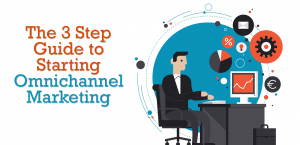Omnichannel is a relatively new concept for today’s marketers. Despite its relatively new tenure in the marketing world, the idea of omnichannel has made a strong impact on businesses and consumers alike, and it doesn’t look like omnichannel is going away anytime soon. In a time where consumers constantly accessible through dozens of marketing platforms, marketers must embrace omnichannel now. Consider these three steps when starting omnichannel marketing, if you haven’t already.
Step one: Find Your DMP
With an omnichannel approach, a data management platform is a must-have for retailers. A data management platform (DMP) collects, manages, processes, analyzes, organizes and activates data. There are plenty of DMPs available to marketers, so choosing the right platform is imperative to your omnichannel success.
There are a few important qualities you may want to consider when choosing your DMP. Businesses should consider how the platform integrates 1st and 3rd party data, how the platform can be utilized, the platform’s cross-channel management abilities, and how easy the platform is to use.
Finding the right DMP can help businesses create a much more comprehensive, 360-degree profile of their customers, a key foundation for marketing personalization.
Step two: Develop Content
The key to a seamless, omnichannel experience lies within the content of the marketing messages that customers receive. Although consumers are receiving messages on different platforms, the messages must be unified and consistent with one another. All messages directed to customers must reflect products and ideas of the overarching marketing campaign.
Developing consistent messaging can be a stumbling block for some businesses. When faced with the dilemma of message uniformity and also personalizing content, marketers often decide to just “batch and blast” generic campaigns across the board. However, with carefully planned strategy and new technology, businesses can combine uniformity and 1:1 personalized marketing with much less effort and spend compared with several years ago.
DMPS and automation platforms can help pull in data from customers so that the right bits of content can be used in messaging, whether it be product offers, copy and language, or design.
Erik Schulze, VP at Yes Lifecycle Marketing, expects that personalization will only become more of a necessity in the next years. In a MediaPost article regarding email marketing personalization, Schulze said, “As the number of emails go up, the engagement with those emails goes down…it’s much more important to have a more personalized discussion or address personal needs.”
And email is just one of the channels marketers should be personalizing…
Step three: Consider all Channels
There are a variety of other channels that retailers should be taking advantage of for optimal coverage.
As the millennial generation becomes the primary target for retailers, companies must adjust their omnichannel strategies accordingly. Raised in an era that incorporates technology into everything, milennials are naturally tech-savvy. Their familiarity with technology will likely influence marketing strategies. Almost three-fourths of today’s consumers believe digital technologies will transform the way businesses use their channels to interact with customers.
Therefore, marketers should be able to access these customers through more, nontraditional channels. This opens more doors for businesses willing to market through social media, apps or SMS. Businesses that are unwilling to embrace new technologies will be left behind.
Despite the increase of technology in today’s marketing, marketers should not forget about old, traditional marketing channels.
Brick-and-mortars, the most traditional channel for marketing, are still important to customers. Brick-and-mortar account for over $4 trillion in sales: a majority of the retail market. Providing an enjoyable in-store experience is still vital for success in the marketing world.
[av_promobox button=’yes’ label=’Check it Out’ link=’manually,//nectarom.com/winners-omnichannel-marketing/’ link_target=” color=’theme-color’ custom_bg=’#444444′ custom_font=’#ffffff’ size=’large’ icon_select=’no’ icon=’ue800′ font=’entypo-fontello’]
If you’re still looking for more ways to get started with omnichannel, check out some of our favorite omnichannel campaigns.
[/av_promobox]




 At this point, you’re still in the preliminary stages of determining whether or not personalization is a right fit for your company. It’s important to find out what you’re really looking for in a marketing personalization suite. Do you need a powerful e-mail, customer relationship management, and personalization tool? Or do you have an email deployment platform already and are looking to supplement your email service provider with marketing personalization?
At this point, you’re still in the preliminary stages of determining whether or not personalization is a right fit for your company. It’s important to find out what you’re really looking for in a marketing personalization suite. Do you need a powerful e-mail, customer relationship management, and personalization tool? Or do you have an email deployment platform already and are looking to supplement your email service provider with marketing personalization?